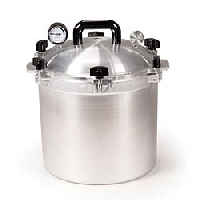What is pressure cooking?
By Catalogs Editorial Staff

What is pressure cooking? It is a fast and healthy way to prepare food
What is pressure cooking? It is food cooked under higher pressure than is used in conventional cooking. The high temperatures occurs when pressure rises to a point greater than atmospheric pressure.
Pressure cookers, made of stainless steel or aluminum, are equipped with a lock-on lid and a pressure relief valve or vent. Generally, pressure cookers are used on the stove top but there are electric models.
How does this work?
Internal temperatures goes up, and steam pressure builds, when placing the sealed cooker over elevated heat. Due to amplified pressure in the pot, liquids do not boil until they reach a higher temperatures, which hastens the cooking process.
Normally, boiling water stays the same temperature. When H2o evaporates, becoming steam, it also stays the same temperature. However, a cooker makes water boil at a higher temperature and creates hotter steam. When steam condenses on cold food items, the heat-transfer capability is increased, resulting in a valuable cooking medium.
~
Fewer nutrients are lost in the process because it is so fast. The nutrient-full steam condenses inside the pot and isn’t lost in the air. Food is not broken up because the pressure is consistent on all surfaces of the food items, which disallows deformation of the items. This method reduces cooking time by two-thirds.
Why pressure cook?
Some prefer pressure cooking because unsafe chemicals do not result — as happens when grilling or baking food. When cooking meat-based dishes, sizable reduction in unsaturated fat content occurs, which is good.
Steam adeptly transfers heat to food upon contact. No damaging of burning of food occurs. This method is effective when cooking large hunks of frozen or fresh meat as well as fragile vegetables.
Busy people like this approach because of its quickness, versatility and because the finished product is healthy.
Heat-sensitive nutrients can be lost in the process; however, using the cooking water on the food is a way of preserving some of the lost nutrients.
Iron can be lost but the upside is pressure cooking improves the digestibility of fiber, protein and starch.
Releasing pressure
When finished, the lid on the cooker cannot be removed until the inside pressure is released. Do not try to force open the lid.
There are three ways to release pressure, including the natural release method, taking 10 to 20 minutes. The pressure slowly reduces on its own.
The second method is cold-water release, which is the fastest approach. Carry the cooker to the sink. Run cold water over the lid. Do not let the water run directly over the pressure regulator or vent. You cannot use this method if using an electric cooker.
The third method is called quick-release. Manually release pressure by opening the valve on the lid. Do not use this method when cooking meat because quick-release can harden meat.
Tips
- When using a pressure cooker, minimal evaporation occurs so less liquid is needed.
- The cooker should not be filled any more than two-thirds full. Do not cram food into the container. If jam-packed, the pot doesn’t work efficiently and the outcome of the food is altered, and not for the better.
- For best results, cut meat into even pieces before putting into the cooker. This ensures uniform cooking.
- When adding various content to the cooker, start with meat, which takes the longest to cook. Stop the pressure and add other faster cooking items, such as vegetables. restart the pressure.
- Cooking time is longer in high altitudes. Boost the cooking time by five percent for every 1,000 feet above the first 2,000 feet above sea level.
Popular Savings Offers











